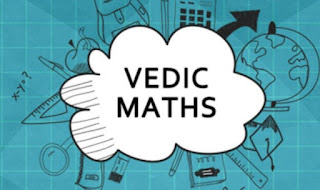VEDIC MATHS-61
VEDIC MATHS
By OMKAR TENDOLKAR
This is post number 61 from the series of "Vedic maths" blogs. Here in this blog we will learn about "Finding Squares of 4-digit number by the Duplex method"
Vedic maths provides a powerful method to compute the square of any number of any length with ease and get the answer in one line. It uses the concept of ‘dwandwa’ or duplex which is explained in this blog.
The Duplex
As the name suggests, duplex simply means dual or something relating to two. We will be using this concept effectively to find out the squares of different numbers. The role of the duplex is to find the squares of numbers.
We will define a term called ‘dwandwa’ or duplex denoted by ‘D’.
Once the concept of ‘duplex’ is clear, we can compute the square of any number very easily. Let us start with the square of a 4-digit number and then extend it to bigger numbers.
Finding Squares Using the Duplex Method
Four-digit squares :
The square of a 3-digit number abc is defined as
(abcd)^2
= Duplex of ( a | ab | abc | abcd | bcd | cd | d)
= D(a) * D(ab) * D(abc) * D(abcd) * D(bcd) * D(cd) * D(d)
Examples :
1.(2894)^2.
Here a = 2, b = 8, c = 9 & d = 4.
Step 1 :
We’ll first find all the duplexes and write them down. We will find the duplex of a, ab, abc, abcd, bcd, cd and d.
- The duplex of 2 is (2)^2, which is 4.
- The duplex of 28 = 2 × 2 × 8 = 32.
- The duplex of 289 = 82 + (2 × 2 × 9) = 64 +36 = 100.
- The duplex of 2894 = (2 × 2 × 4) + (2 × 8 × 9) = 16 + 144 = 160.
- The duplex of 894 = 92 + (2 × 8 × 4) = 81 + 64 = 145.
- The duplex of 94 = 2 × 9 × 4 = 72.
- The duplex of 4 = (4)^2 or 16.
Now we’ll arrange the duplexes and then add them up in the next step 4|32|100|160|145|72|16
Step 2 :
In this step, we’ll start adding from right to left.
4|32|100|160|145|72|16
= 8375236
- First, we’ll put down 6 from 16 and carry one to the ten’s place. So our unit’s digit is 6.
- 72 + 1 (carried over) = 73. Now we’ll place 3 down and carry over 7 to the next column. So our ten’s digit is 3.
- 145 + 7 (carried over) = 152. Here we’ll put down 2 and carry over 15 to the next column.
- 160 + 15 (carried over) = 175. We’ll now put down 5 and carry over 17 to the next column.
- 100 + 17 (carried over) = 117. Now we’ll place 7 down and carry over 11 to the next column.
- 32 + 11 (carried over) = 43. So we now need to take down 3 and carry over 4.
- Finally, 4 + 4 (carried over) = 8. So our final answer is 8375236.
(2894)^2 = 8375236.
2. (1234)^2
Here a = 1, b = 2, c = 3 & d = 4..
Step 1 :
We’ll first find all the duplexes and write them down. We will find the duplex of a, ab, abc, bc and c.
As usual we put down all the duplexes.
- So the duplex of 1 is (1)^2 = 1.
- Next, we’ll find the duplex of 12, which is 2 × 1 × 2 = 4.
- The duplex of 123 = 22 + (2 × 1 × 3) = 4 + 6 = 10.
- Now the duplex of 1234 is (2 × 1 × 4) + (2 × 2 × 3) = 8 + 12 = 20.
- The duplex of 234 = 32 + (2 × 2 × 4) = 9 + 16 = 25.
- Next, we’ll find the duplex of 34, which is 2 × 3 × 4 = 24.
- Finally, the duplex of 4 is (4)^2 or 16.
Now we place all the duplexes like this: 1|4|10|20|25|24|16
Step 2 :
Now all we have to do is add up these duplexes.
1|4|10|20|25|24|16
= 1522756
- So we’ll place the 6 of 16 in the unit’s place and we’ll carry 1 over to the next column.
- 24 + 1 (carried over) = 25. We then place 5 down in the ten’s place and carry over 2.
- 25 + 2 (carried over) = 27. We now place 7 and carry over 2 to the next column.
- 20 + 2 (carried over) = 22. So we’ll now place 2 down and carry over 2 to the next column.
- 10 + 2 (carried over) = 12, so the cycle goes on. We’ll now put down 2 and carry over 1 to the next step.
- So 4 + 1 (carried over) = 5. We now place this 5 down and, voila, there is nothing to carryover!
- Now bring down 1. And there you have it, our answer is 1522756.
Answer:
(1234)^2 = 1522756.
- (2103)^2 = 4| 4| 1|12| 6| 0| 9 = 4422609
- (1333)^2 = 1| 6|15|24|27|18| 9 = 1776889
- (1231)^2 = 1| 4|10|14|13| 6| 1 = 1515361
- (2419)^2 = 4|16|20|44|73|18|81 = 5851561
- (5706)^2 = 25|70|49|60|84| 0|36 = 32558436
In next blog we will discuss about "The concept of Positive Osculator".
We will meet very soon through our next blog. Till that stay connected, stay healthy and stay safe.
Thanks
for giving your valuable time.


Comments
Post a Comment